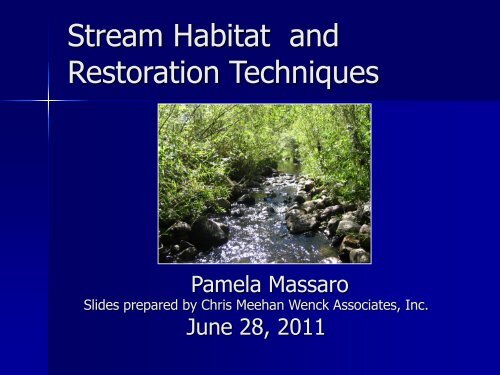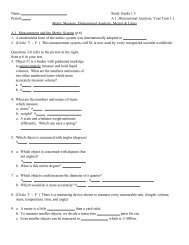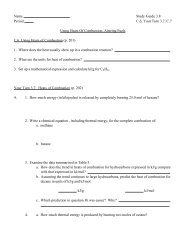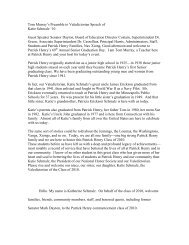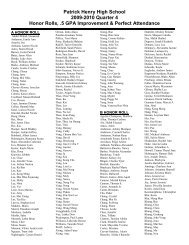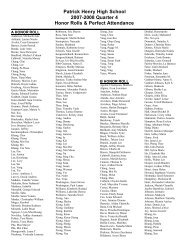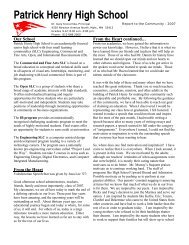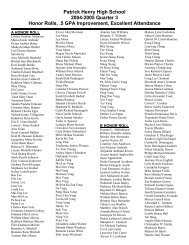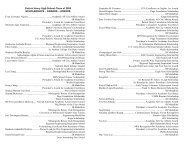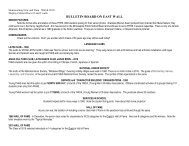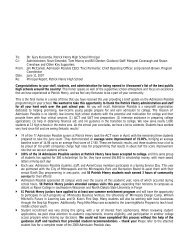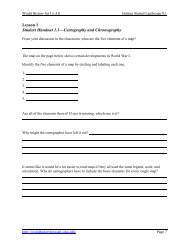Stream Habitat and Restoration Techniques - History
Stream Habitat and Restoration Techniques - History
Stream Habitat and Restoration Techniques - History
Create successful ePaper yourself
Turn your PDF publications into a flip-book with our unique Google optimized e-Paper software.
<strong>Stream</strong> <strong>Habitat</strong> <strong>and</strong><strong>Restoration</strong> <strong>Techniques</strong>Pamela MassaroSlides prepared by Chris Meehan Wenck Associates, Inc.June 28, 2011
What can be improved onthis stream?
Overview• What impacts a stream?• Who lives in a stream?• How can we improve a stream?
What impacts a stream?• Water– Volume– Rate (Velocity)• Quality of <strong>Habitat</strong>– Vegetation– Structure• Water Quality– Oxygen– Other constituents
Water• Volume– Increases due tourbanization– Creates floodingconcerns• Rate– Velocity – Runoffhappens quicker– Results in erosionwww.eoearth.org/article/Surface_water_management
<strong>Habitat</strong>• Vegetation– Provides shelter<strong>and</strong> food source– locks stream bankin place• Structure– Serves asspawning habitat– Introduces oxygen
Water Quality• Contaminants– Point/Non-PointDischarges• Temperature• Dissolved Oxygen• Fecal Coliform• Sediment• Chloridehttp://www.tpwd.state.tx.us/learning/webcasts/livedive2001/images/lcra/image5.jpg
What will happen here?
<strong>Stream</strong> Invertebrates• Much of the aquatic life in streams iscomposed of benthic macroinvertebrates.• Macroinvertebrate includes clams, crayfish,worms, <strong>and</strong> insects.• Macroinvertebrates do not have internalskeletons, <strong>and</strong>, typically, live on a streamsubstrate (bottom, woody debris,macrophyte, etc..)
Shredders• Dominant food– Plants– Coarse particulate organic material (CPOM)– Wood• Feeding mechanisms– Herbivores - Chew <strong>and</strong> mine live plants– Detritivores - Chew on CPOM• Representatives– Scathophagidae (dung flies)– Tipulidae (crane flies)Crane flies
Collectors• Dominant food– Decompose fine particulate organic matter (FPOM)• Feeding mechanisms– Filterers - Detritivores– Gatherers - Detritivores• Representatives– Filterers• Hydropsychidae• Simulidae (black flies)– Gatherers• Elmidae (riffle beetles)• Chironomini• Baetis• Ephemerella• Hexagenia
Scrapers• Dominant food– Periphyton (attached algae)• Feeding mechanisms– Graze <strong>and</strong> scrape mineral <strong>and</strong> organic surfaces• Representatives– Helicopsychidae– Psephenidae (water pennies)– Thaumaleidae (solitary midges)– Glossosoma– Heptagenia
Predators• Dominant food– Living animal tissue• Feeding mechanisms– Engulfers - Attack prey <strong>and</strong> ingest whole animals– Piercers - Pierce tissues, suck fluids• Representatives– Engulfers• Anisoptera (dragonflies)• Acroneuria• Corydalus (hellgrammites)– Piercers• Veliidae (water striders)• Corixidae (water boatmen)• Tabanidae (deerflies & horseflies)
<strong>Habitat</strong> Requirements• Shredders: backwaters, overhangingvegetation, leaf packs• Collectors: riffles, woody debris,substrate• Scrapers: rocks, riffles• Predators: clear water, vegetation,rocks
Fish <strong>Habitat</strong> Requirements• Top of the food chain: need inverts• High dissolved oxygen: riffles• Clear water: visual predators• S<strong>and</strong> <strong>and</strong> gravel substrate to spawn• Pools, backwaters• Overhanging vegetation• No barriers
How can we improve thishabitat?
Shingle Creek -Existing ConditionMinimal Stability providedby VegetationOverwide, Still ChannelUndercutBanks
View upstream illustrating improvementsSplit Rail Fenceprovides physical<strong>and</strong> visual edgeProperty Boundaries markedby Massed Shrub PlantingsBank Stability providedby Rooted VegetationLower Channel with greater stream velocity, <strong>and</strong>structures that direct flow to stream center
Vegetative Treatments
Native buffers• Long rootsstabilizestreambanks• Filterstormwater• Provide bird<strong>and</strong> otherwildlife habitat(snappingturtles)
Emergent Plantings• Use inbackwaterpools• Vegetateflatsbetweenbankfull<strong>and</strong>floodplain
Gooseexclusionwire
What can we do toimprove?
Live Stakes
Live stakes– just afterinstallation
Fascines
Uses of Fascines
Brush Bundle
What do you recommend?
Structural TreatmentOptions
Dual purpose as afish ladder “rock-rampfishway”
Riffle
Caddisfly netsRock <strong>and</strong> cobblesubstrate
Rock Vanes
Rock Structures
Channel Reconstruction
Alternative GradeControls
Structural <strong>Habitat</strong>Improvementswww.midmotu.org/articles/Article_111105.htm
Fish LadderA verticalslot fishladder inFyrisån(Fyris river)Uppsala,Sweden.Photographer: CMG Lee
Pool <strong>and</strong> Weir Fish LaddersSide channel salmonfish-ladder at CapilanoRiver Regional Park,Canada (299 feet oflift).John Day Dam fish ladder on the ColumbiaRiver Oregon, USA (110 feet of lift).Source: USACEPhotographer: Arnold C
Root Wads
Root Wad <strong>and</strong> Log
Pike Creek: We need your help
SpringSpringfollowingfollowingWinterWinter20032003constructionconstruction
Fall 2005Fall 2005
After . . .. . . Before
After . . .. . . Before
Fall 2007
WoodsCreek-Help usagain
Woods Creek-2009
Summary• Most stream restoration projects are acombination of bioengineering <strong>and</strong>structural improvements• With a thoughtful approach, streamscan be stabilized to convey designflows <strong>and</strong> also provide water quality<strong>and</strong> habitat improvements


